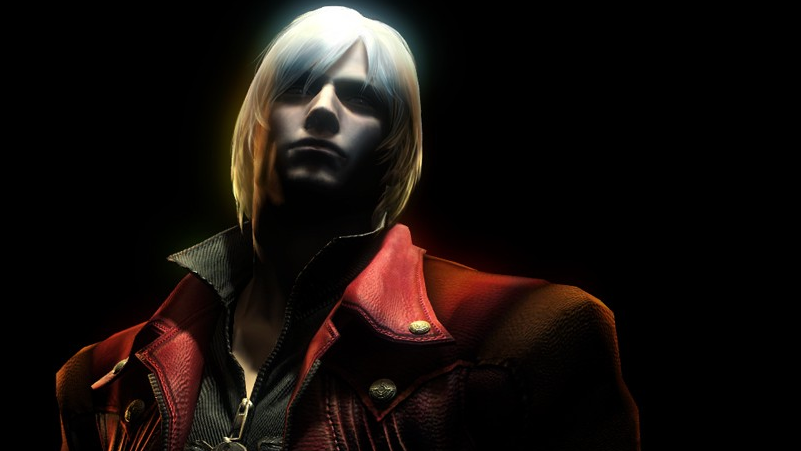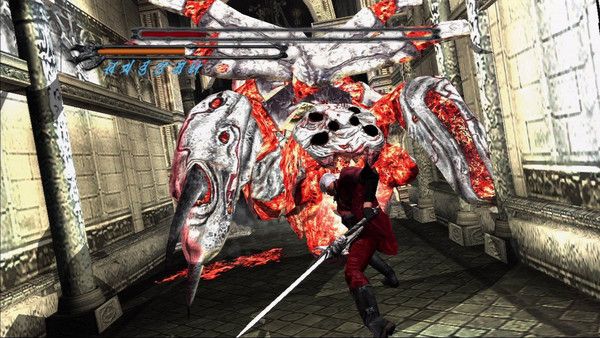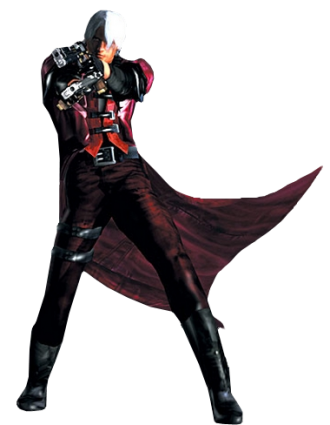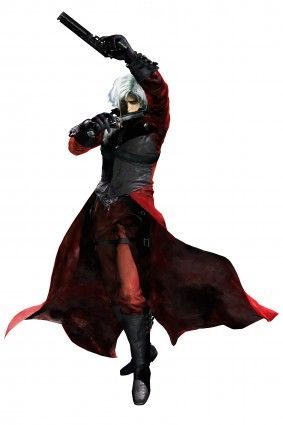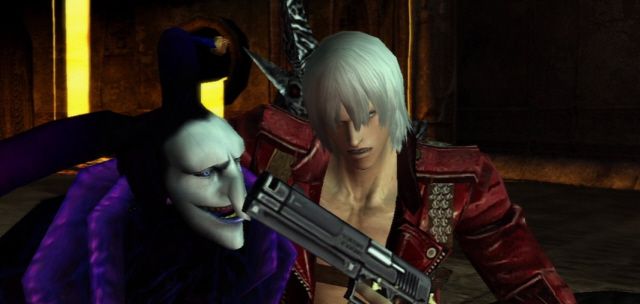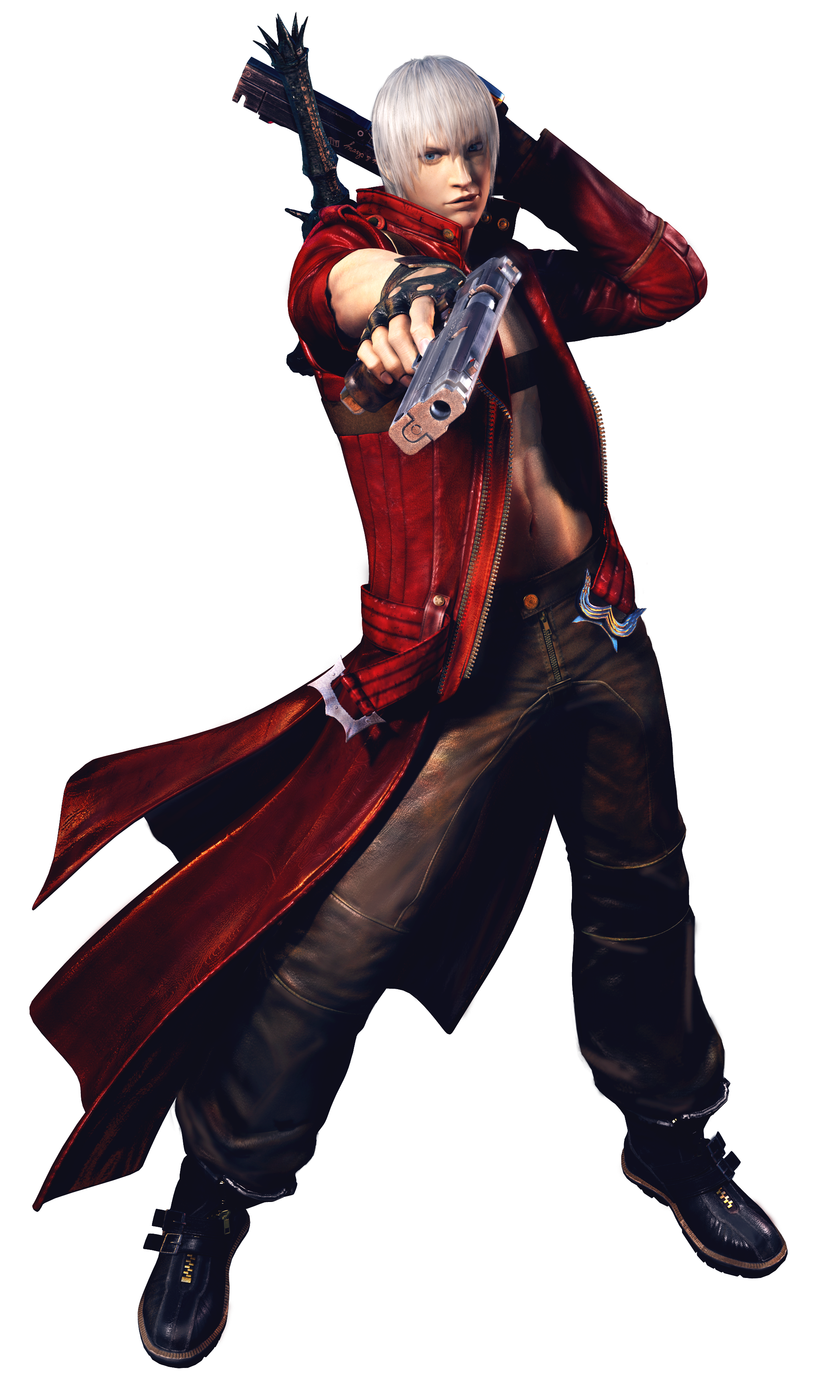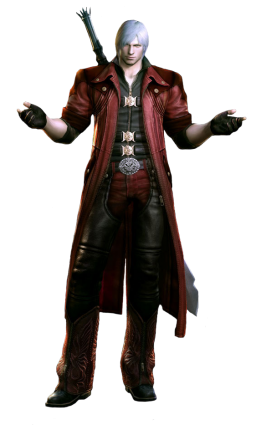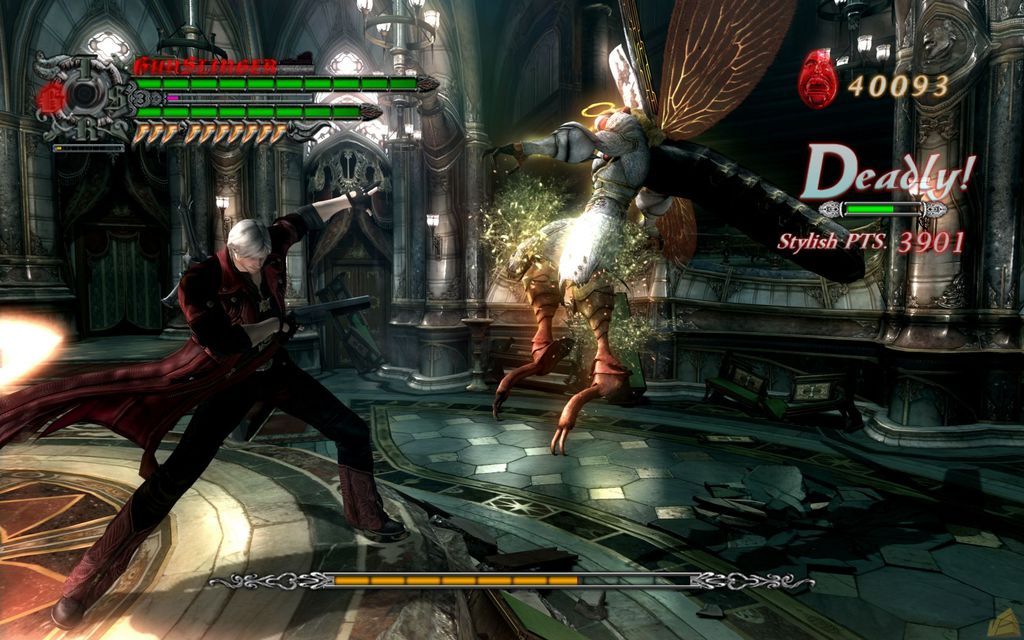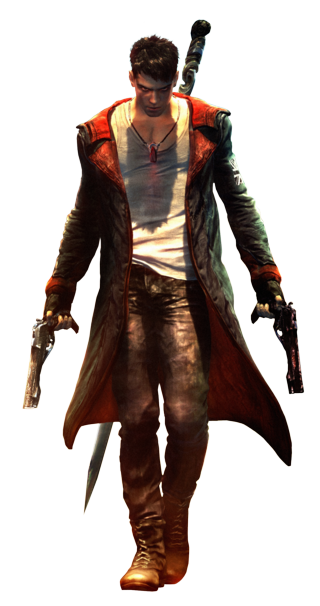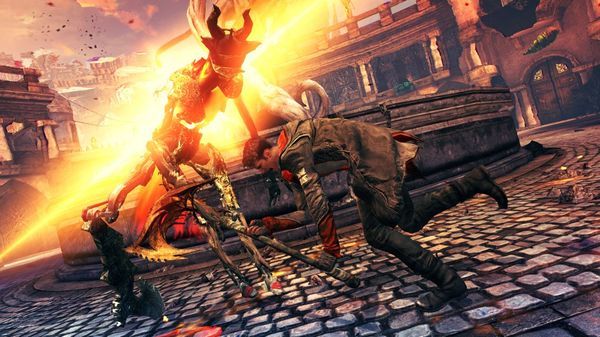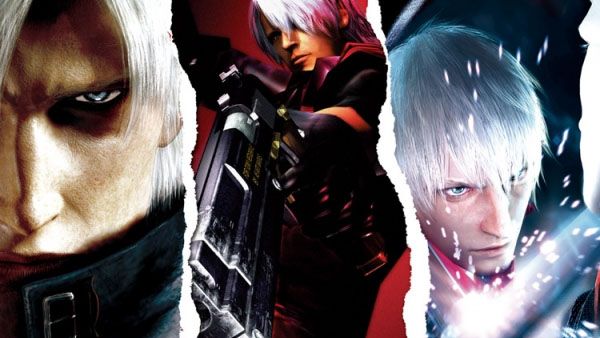The Devil May Cry series is one of the most celebrated gaming franchises of the new millennium. Its name is synonymous with the series’ now trademark "stylish action". Nearly as old as the PlayStation 2 itself, the series has spawned multiple video games, toys and action figures, a manga series, an anime series, books and much more, elevating Dante, the series’ cocky, mouthy main character to iconic heights.
While his career definitely isn’t without a few flat notes, Dante is one of gaming’s best known faces. Let’s reflect on the past and present, and ponder the future of the immensely popular Devil May Cry series.
Devil May Cry – 2001: Introducing Stylish Action
I can remember where I was when I saw the commercial for the first Devil May Cry game 12 years ago. Dante launched a monster into the air with a fast, effective swipe of his sword and then juggled it with a stream of fire from his twin pistols. There was something so fascinating about seeing that that I just had to have the game. Dante’s design was bizarre but somehow still appealing. His hair – which was as white as snow – contrasted sharply with his bright, crimson coat.
The game contained some amount of platforming and a few hidden things to discover, but the most important component in the seminal Devil May Cry was easily the combat. Players were challenged to defeat enemies as quickly, and yes – stylishly – as they could.
By switching through skills and weapons you could impress the game’s style meter. This game changing mechanic rewarded players for skillfully cycling through their weapons and evading damage while dispatching their foes, but it pretty much ignored the fly by night button mashers.
Thus, this title had pioneered stylish action. If you wanted a high score you couldn’t just button mash, you needed to dance around your enemies attacks while taunting and implementing the full array of Dante’s capabilities. This mechanic has bled over into numerous titles and franchises, perhaps most notably Platinum Games’ lauded Bayonetta. Dante’s debut outing captivated critics and gamers the world over, earning unanimous praise and commercial success.
As of now the title holds an impeccable 94 rating on review aggregate Metacritic and to date it has reportedly sold nearly three million units globally. With the fortune and fame the first game had amassed, replicating the success with a quick sequel should have been a cinch right? Wrong.
Devil May Cry 2 – 2003: Apparently Devils Do Cry (Or At Least Mope)
Devil May Cry 2 received much of the same promotion as the first game. It had television commercials, magazine spreads and flocks of fans eager to play it after enjoying the first game. While much of what made the first game such a hit did remain intact – such as the cryptic music and Castelvania-esque settings – a few deviations brought a severe backlash from critics and fans alike.
Chief among the complaints were Dante’s new somber, moping, enigmatic attitude and the overall ease of the game. In particular, the unresponsive and less aggressive enemies allowed players to easily spam their way through the game. This problem was twofold: not only did it truncate the rich stylish action pioneered by the first game, but it also revealed a relatively weak underlying combat system.
Dante’s slow sword strikes and gun spam easily defeated the throwaway enemies. Top that with easy, unimpressive bosses, an unusually harsh style meter (which seems quite odd given the weaker combat and enemies), a host of camera and targeting issues and Devil May Cry 2 was a recipe for disaster. Several other complaints were leveraged against the game that I’ve chosen to omit.
Suffice it to say that it was generally not liked. Critics had their way with DMC2, and the title was unanimously roasted. It has earned a puny rating of 68 on Metacritic. The game’s commercial success unsurprisingly failed to eclipse that of the first game, reportedly moving just over two million copies to date. Although the game is universally cited as a low point for the series, a small group of players still enjoyed DMC2 for what it offered. It introduced multiple playable characters to the series and sported some very interesting costumes.
Capcom wasn’t content to let this misstep kill the DMC franchise after the success of the first game. So, they took responsibility for their mistakes, listened to their fans and righted their wrongs (things that, nowadays, many would dub Capcom incapable of). Enter Devil May Cry 3.
Devil May Cry 3: Dante’s Awakening – 2005: Back with a Hellish Vengeance
In 2005, Capcom released Devil May Cry 3: Dante’s Awakening for the PlayStation 2. This title addressed most of the complaints fans had about DMC2 and then some. Set before the events of the first game, DMC3 featured a young, hard headed Dante. This Dante wasn’t the Debbie Downer that appeared in DMC2, but was instead a sarcastic, loud mouthed idiot that was so corny you couldn’t help but like him.
Cheesy one-liners aside, the biggest improvement over the last game was the depth and speed of the combat. Instead of crawling around, Dante now flew around the battlefield faster than ever before, assimilating foes in a flurry of sword slashes, shotgun blasts, flying kicks and much more. DMC3 introduced combat styles to the series. These styles, such as Swordmaster and Trickster, equipped Dante with a variety of different techniques. Importantly, most of these combat styles were weapon independent, allowing the player to mix and match styles and weapons as they saw fit.
The result of this was by far the deepest combat the series had seen up to this point. Players could execute demons in a dazzling display of technical skill and mastery. The style meter was addressed and now responded better to varied strings of attacks. The enemy AI was ramped up and enemies were aggressive and restless during combat. Dante commanded a huge arsenal of weapons, all of which were useful and added considerable nuance to the combat.
Boss fights were taxing and intense, and customizable controls made a triumphant return (although I typically don’t have a problem with default layouts). The game generally seemed closer to DMC than to DMC2, and the series’ renown challenge was back in full force. Devil May Cry 3 delighted fans and critics alike.
Response to the game was so positive that Capcom went on to re-release the game as Devil May Cry 3: Special Edition. Special Edition folded a heap of new goodies into the already stellar game, including a gallery for cutscene viewing, even more difficulty settings, a ridiculous turbo mode, more costumes, the intimidating bloody palace and refined mechanics.
Most importantly, Special Edition introduced a playable character arguably more popular than Dante himself: Dante’s brother Vergil. The PS2 version of Devil May Cry 3: Special Edition (it also spawned a PC port) has earned a commendable Metacritic score of 87 and both versions of DMC3 have reportedly sold a combined *two million units globally.
A year after the release of DMC3, Capcom released the Devil May Cry: 5th Anniversary Collection, which included all three games.
(*Fixed, I misread the report. )
Devil May Cry 4 – 2008: Polishing Stylish Perfection
When Devil May Cry 4 released for PS3, Xbox 360 and PC, there were really only a few things fans expected from it. In terms of the combat system, one would have a difficult time imagining several ways anyone could improve on what had been accomplished in DMC3. Maintaining the combat system, continuing the story, and delivering stunning HD visuals were really the only things Capcom needed to achieve for fans to hungrily soak DMC4 up. And for the most part, that’s exactly what they did.
The game looks brilliant, with wonderfully detailed characters, enemies and environments. The flashy, stylish combat is captured spectacularly at 60 frames per second. DMC4 introduced a new lead protagonist, the young knight Nero with a striking resemblance to Dante and Vergil. The story focuses mostly on him rescuing his love interest (yawn). He shares the spotlight with Dante throughout the campaign, providing yet another opportunity for multiple playable characters.
Dante controls a wee bit more sluggishly than he does in DMC3 but not extremely so (and he’s definitely still far more agile than DMC2 Dante). His combat is noticeably limited compared to in DMC3 due to the lack of as many styles or weapons, but there is still a great amount of freedom and depth afforded by his arsenal. He can switch styles on the fly and taunt and evade enemies while putting on a dazzling show with fantastic new weapons like Lucifer and Pandora.
Furthermore, although he’s noticeably older, Dante is still the cocky, mouthy showoff we’ve grown to love. Nero controls completely differently, and is equipped with only a single sword, a single gun and his possessed arm A.K.A. the Devil Bringer. His chargeable motorized sword and upgradeable gun contain dozens of combos and techniques. The Devil Bringer allows for some incredibly advanced and powerful techniques, such as jump cancelling the enemy step.
Between Dante and Nero, DMC4’s combat is quite rich and Nero’s new mechanic adds a new layer of technical depth and strategy. Like its predecessor, DMC4 also sported a mess of challenging bosses and enemies, puzzles and platforming, tons of upgrades, lots of difficulty settings, the bloody palace, hidden extras, over the top cutscenes, a thumping rock soundtrack and everything else fans loved in DMC3. It also did all of this while looking absolutely fantastic.
By giving fans exactly what they wanted in the prettiest package ever, Devil May Cry 4 yet again won critical and commercial acclaim. Combined sales of the PS3, PC and Xbox 360 versions of the game have reportedly cleared three million units and it currently holds a respectable 84 on Metacritic. This title also spawned an iOS port, the reportedly terrible Devil May Cry 4: Refrain. Furthermore, Capcom also released the Devil May Cry HD Collection, a compilation of the first three games remastered in HD, in 2012, presumably to whet fans’ appetites as they awaited the next release.
The most consistent complaint that I’ve heard about DMC4 is that the game is too similar to the other games. By this point the series was apparently, allegedly, getting dated and outclassed by newer franchises. It needed to change, to freshen up, to somehow reinvent itself. Three million units may have been good for a PS2 game, but that figure is evidently too low for a current gen console game. Capcom also heard the minor complaints about the series growing old and they devised a plan to reinvent or reboot the series and make it appealing to a whole new generation of gamers. Queue catastrophe.
(DMC4 is the subject of one of our Shock Value columns. Check it out here. )
DmC: Devil May Cry – 2013: Devils May Not Cry, But Fans Definitely Do
Although only two years passed between the release of DMC4 and the reveal of the series reboot, looking back it seems like a much longer stretch of time. The Devil May Cry “reboot” – codenamed DmC – was first shown off at the 2010 Tokyo Game Show. It was here that gamers got their first look at the hero who would star in the reboot, our first look at Dante.
Compared to the Dante that has appeared in all of the DMC titles up to this point, DmC’s Dante was quite literally unrecognizable. His bright white hair, fair skin, muscular build, rich red garments and general anime flair were nowhere to be seen. Instead, Dante was lanky and pale, his hair was short, untidy and black, and his clothes were dingy, tacky and probably fairly smelly. He smoked. He said swear words. The hilariously cocky, cheesy and straight up stylish charm of the original Dante wasn’t present. This Dante was unhappy, gritty, emo and for the most part irritating. Name aside, he was simply not the now iconic action star fans had come to love and expect.
To me and to several other series fans, this new Dante wasn’t at all cool or appealing. It was more than just the change in hair color (which dozens of deaf optimists have tried to boil the complaints down to) that upset fans. It was the perceived change in character.
From the moment that first trailer was shown off, the internet simply exploded into an uproar about the design of the new Dante. Longtime series fans swore not to buy DmC (well before any concrete game-play details were available) and much of the fandom collectively perceived the redesign as Capcom’s attempt to try and “westernize” the beloved series, for sales reasons of course. Fans created and suggested their own redesigns of Dante and some even sent death threats to members of the development team.
The fire of the fan outrage (which Capcom and Ninja Theory’s scant and smug remarks merely stroked) continued to burn right up until the game released in January of 2013.
Surprising no one but the most dedicated haters, Ninja Theory’s DmC proved to be a commendable action game. It is easily the most story driven of all of the games in the series, creating a new backstory for Dante and Vergil and introducing several new characters. On top of its (relatively) strong storytelling, DmC featured magnificently designed stages and vivid art design. In terms of the combat system, DmC unfortunately pales in comparison to DMC4 and especially Bayonetta.
The meager selection of weapons afforded the combat far less depth than that found in the aforementioned titles, but this did little to diminish the game overall. Interestingly, Dante’s Angel Glide and Lift techniques are actually just slight variations on functions of Nero’s Devil Bringer. The new Dante is still pretty irritating, but DmC easily hits enough high notes to make the character bearable. In a startling contrast to the initial reaction to the game, DmC struck a chord with critics and earned a handsome Metacritic score of 86.
Unfortunately, the longtime fans who swore not to buy the game may have stuck to their word. The game faltered at retail, selling far less than Devil May Cry 4 in most, if not all territories. Capcom cut their sales forecast for the game by a startling amount, and to date combined sales of all versions of the game are reportedly just over one million units globally. For comparison’s sake, consider that DMC4 shipped more than two million units globally after being available for just one month.
Ignoring all signs to the contrary, Capcom gave fans what Capcom thought was best instead of what fans wanted, and believed that DmC would reel in enough new fans - old fans be damned - to be a huge commercial success. Or maybe they thought that old fans would inevitably be won over by the new Dante’s profuse swearing and DmC’s competent though relatively shallow combat system. Either way, although it maintains a Metacritic score higher than DMC2 and DMC4, DmC is currently the worst selling main title in the series.
(Check out our initial response to Dante’s redesign here and our review of DmC here.)
Where the Devil Do We Go From Here?
Unlike the other franchises this column has focused on, the future of the Devil May Cry series seems decidedly unclear. With Capcom’s current attitude regarding profitability, the series as we know it may get the axe. After all, this is the same company that is releasing an unprecedented five Street Fighter IV re-releases, planning to release even more (even more?) DLC and apparently shafting the dearly beloved Mega Man series, even cancelling the fairly anticipated Mega Man Legends 3 and blaming fans – a sharp deviation from listening to fans and taking responsibility for their own failures.
Some outlets also blamed fans for DmC’s sales shortcomings, as if Capcom isn’t solely responsible for completely disregarding the vitriolic backlash from longtime fans after the game’s initial reveal. In this day and age, Capcom doesn’t blame themselves, they blame the fans, and as a result of this, it wouldn’t surprise anyone if we never saw another Devil May Cry branded title again.
Assuming they do swallow their pride and pull themselves up by the boot straps, the series could logically go in one of two directions. The first and most likely route would be to let Ninja Theory develop DmC2, which would expand upon the new characters and lore established in the first game. The second and probably very unlikely route would be to let the DMC4 developers take back the reins and develop Devil May Cry 5. DMC5 could bring back the loud mouthed, healthy, non-smoking, non-swearing goofball Dante we love, continue his story from Devil May Cry 2, and bring back the ridiculously rich and solid combat system, tons of weapons, difficulty and on and on and on.
I know as well as the next person that this probably will never happen, but hope is a good thing.
Regardless of where it goes next, Devil May Cry is a widely celebrated series. It hasn’t achieved Call of Duty sales success (and let’s be honest – only Call of Duty has) and it doesn’t quite rank amongst gaming’s oldest franchises, but it is passionately loved by a dedicated, hardcore and quite clearly very vocal group of fans. Each pre-DmC title has sold millions of units and the vast majority of them have won over critics and fans alike. With its complex combat systems, renown difficulty and ridiculous main character, the Devil May Cry series has slashed its own stylish place amongst gaming’s greatest franchises. We can only hope that Dante will get to shine in many more thrilling adventures.

